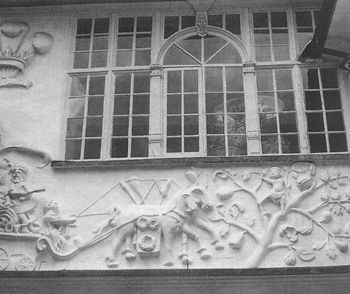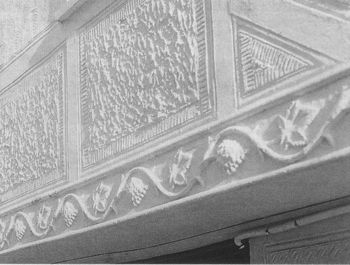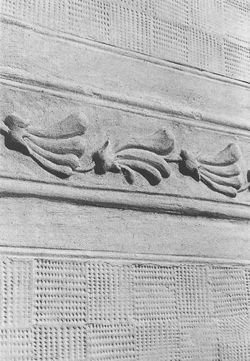Pargeting
Tim Buxbaum
 |
|
| A delightful example of 17th century pargeting on the Ancient House, Ipswich | |
 |
|
| Different pargeted textures on the Salisbury Arms Hotel, Hertford with a plaster vine frieze at the jetting |
Pargeting is the ornamentation of plastered and rendered building facades that would otherwise be smooth, lined-out or roughcast. The term was once also used to include internal decoration. Pargeting ranges from simple geometric surface patterning to exuberant sculptural relief of figures, flowers and sea monsters, but it is only skin deep, applied onto masonry or a lathed, timber-framed wall.
THE HISTORY OF PARGETING
English plasterwork became increasingly elaborate in the 16th century and the dramatic external decoration of Henry VIII's Nonsuch Palace (1538) was contemporary with early plaster friezes in the great houses. Some of the most opulent pargeting was produced over the next 150 years with a high point around 1660 (for example, Ancient House, Ipswich, and the Sun Inn, Saffron Walden), then the technique began to fall out of fashion.
In the last decades of the 19th century architects like Norman Shaw became interested in the 'arts and crafts' skills of an earlier age and there was a revival of interest in pargeting. But it was more controlled, precise and scholarly, better suited to more regular buildings.
Irrespective of fashion, calm almost dateless pargeting flourished in many country districts. Beware - dating pargeting can be risky - what you see may have been remade several times in an approximation of the original pattern!
REGIONAL DISTRIBUTION
East Anglia is the traditional home of pargeting, but it can also be seen in Kent and is documented as far away as York and the West Country. There was plenty of pargeting in London before the 1666 Fire. Neglect, redevelopment, fire and changing taste are the main enemies of pargeting which may simply survive in East Anglia because of a slower rate of change and less industrialisation.
STYLES AND TECHNIQUES
The simplest pargeting takes the form of lines scratched with a stick across wet plaster to create, for example, a lattice within a border. More complexity comes from using fingers and combs or moulded templates, incising or impressing chevrons, scallops, herringbones, guilloches, fantails, rope patterns and interchanging squares.
 |
|
| Detail of a frieze type typical of Yoxford, Suffolk with an impressed dotted pattern. |
It is important that the individual strokes are sublimated to overall effect and precision is often less important than correct texture, itself affected greatly by orientation to sunlight and ability to weather. The rhythm of the chosen pattern, its scale, weight and proportion directly relate to the type of building being embellished, so that subtlety and understatement can be more effective than over-enthusiasm.
Precast decorations can also be used, with friezes and three dimensionality added, given suitable structure. There is no reason why contemporary designs cannot be devised to suit new buildings.
MATERIALS USED
The original raw material is parge, a mixture of sand and lime with a binder like hair, traditionally used for parging flues and underlining roof tiles to reduce drafts. Many additional ingredients are recorded, including stable urine, loam, soot, tallow, road scrapings, cheese, dung, blood and salt, the aim being to produce a viscous material slowly curing to something leather hard. If it cured too quickly it would be difficult to work up a complex pattern; if it cured too slowly the frost might catch it.
Traditional mixes might be applied in two or three layers finished with a limewash sheltercoat (repeated layers may obscure the design); later pargeting often contains cement, sometimes in sufficiently high proportions for the ornamentation to appear harsh, with a greater risk of cracking.
~~~
Recommended Reading
- John Ashurst, Practical Building Conservation Volume 3: Mortars, Plasters and Renders, English Heritage, Gower Technical Press, Aldershot, 1988
- Essex County Council, Traditional Building Materials in Essex: Pargeting, Essex County Council, 1982
- William Millar, Plastering Plain and Decorative, (1897), Donhead, Shaftesbury, 1998
- John and Jane Penoyre, Decorative Plasterwork in the Houses of Somerset 1500-1700, Somerset County Council, 1994
- Eric Sandon, Suffolk Houses: A Study of Domestic Architecture, Baron Publishing, Woodbridge, Suffolk, 1977
- John Schofield, Medieval London Houses, Yale University Press, London, 1994



